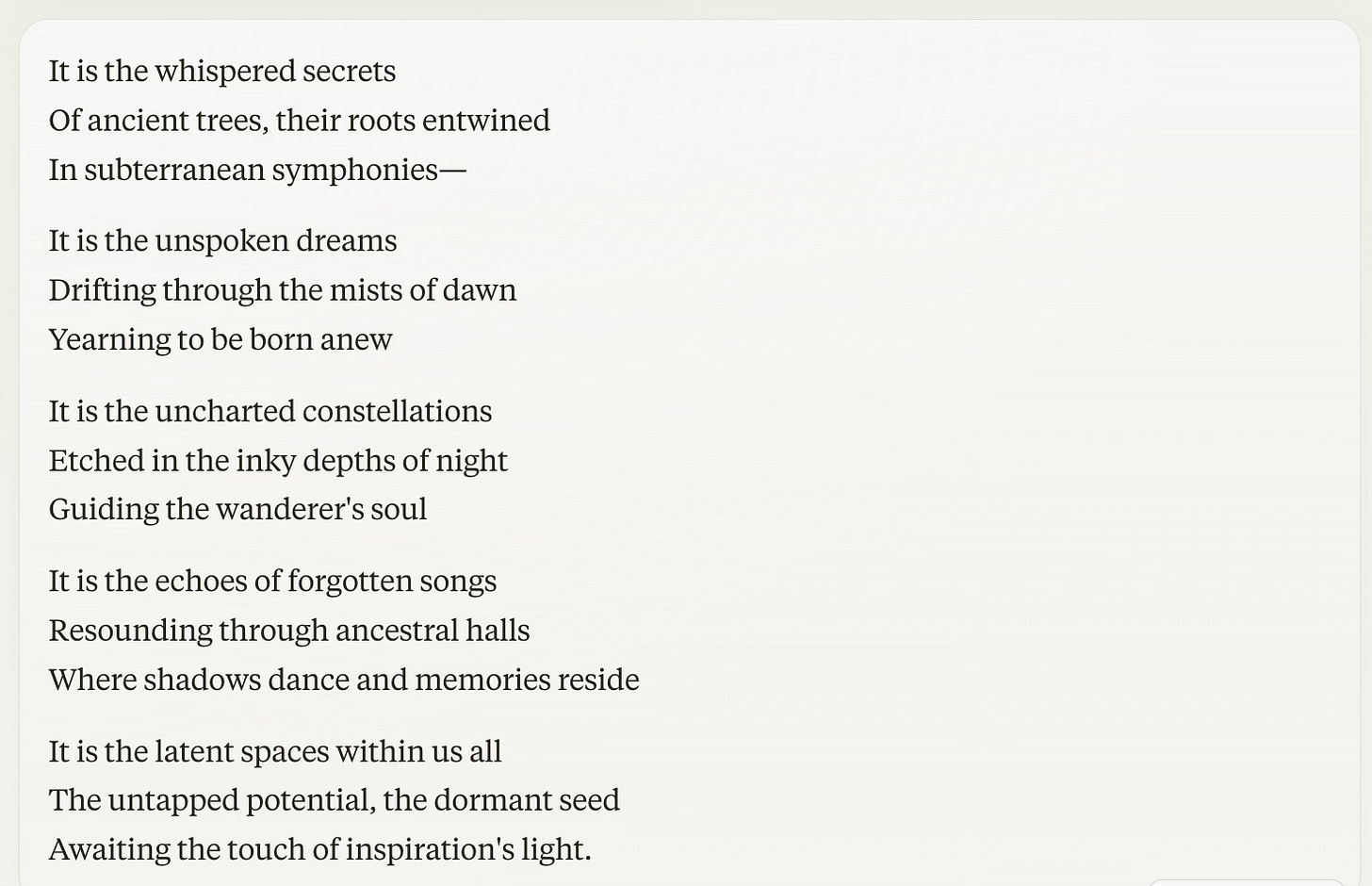AI Poetry Experiment #1: Latent Spaces
Claude 3 Opus and Poetic Co-Creation
I’m astonished by Claude 3.0 Opus’s creativity relative to other LLMs.
During this morning’s Sunday yoga practice, at the concluding Ommmmmm—I had an idea for a poem I might co-create with Claude. I wanted to see what it would do with it. This traces the creative process from start to finish.
I’ll start with the final product:
Latent Spaces
It is the Ommmmmm reverberating
From the heart of Namche to the
Wellspring of time and space—It is the palimpsest engraved
Deep upon the cosmos
The unrevealed sculpture in the rock—It is the hidden glyphs upon
A Dead Sea scroll
The mycelium and the rhizome
Beneath the earthen vaultsIt is the silence before the first note is sung
The breath between heartbeats, the pause before the plunge
Into the unknown depths, the uncharted seaIt is the dark matter, the unseen shores
Where waves of probability break and roar
Shaping the contours of realityIt is the truth that lies too deep for speech
The wordless knowledge, the bone-felt certainty
The whisper of the universe in our cellsIt is the latent spaces, the hidden realms
Where seeds of being lie in potent calm
Awaiting the fracturing of eternity's shellWe stand upon the shore,
pondering
The vast, inscrutable expanse,
wondering
What undreamt structures of thought,
what unborn
Modes of knowing, might illuminate
these spaces,
Beckoning,
shimmering,
glimmering
At the boundaries of our
understanding.
Considering where language models were only a couple years ago, or even a few weeks ago, I think this is startling progress. But it should be noted that this was a co-creative process; I had the germ of an idea I jotted down as I sat in my car. I see enormous potential in humans working with AI to sculpt your way to creative products; the entire process here took about 20 minutes. And I imagine you could do this for all kinds of writing, science, etc.
Here’s where I started with Claude 3 Opus, including my own original prompt which emerged from the latent space of my own brain:
Claude’s first reaction was to try and capture a series of similar metaphors (it did a good job of understanding what I was getting at):
But it didn’t really capture my intention—which is at the core of what art must contain. So I helped clarify it a bit:
I gave it some more feedback to tighten it up:
But the concluding section wasn’t good enough so I focused in on that:
From here I wanted to challenge the reader a bit more, to get them thinking about the topic rather than handing them an answer:
This was moving in the right direction but I thought we could also get more creative with the structure of the ending:
I really liked the repetition of pondering/wondering and thought it lended it a bit of a musical quality, so I wanted to stick with that:
…although Claude didn’t quite get what I was looking for, so I clarified it and then it made a big improvement:
Here’s the final version, after I also fixed the spelling of Namchi to Namche (which wasn’t Claude’s fault, I had mis-remembered the place name of a location in the Himalayas I’d been to):
Who is prompting who? As much as I was prompting Claude, it was also prompting me.
As I’ve noted in my writing about artificial intelligence in games, the creative process may sometimes look more like sculpting: an interactive process where you provide the AI with the germ of an idea, and work to-and-fro until you reach a satisfying result.


















Interesting journey in prompt engineering - thanks for sharing!